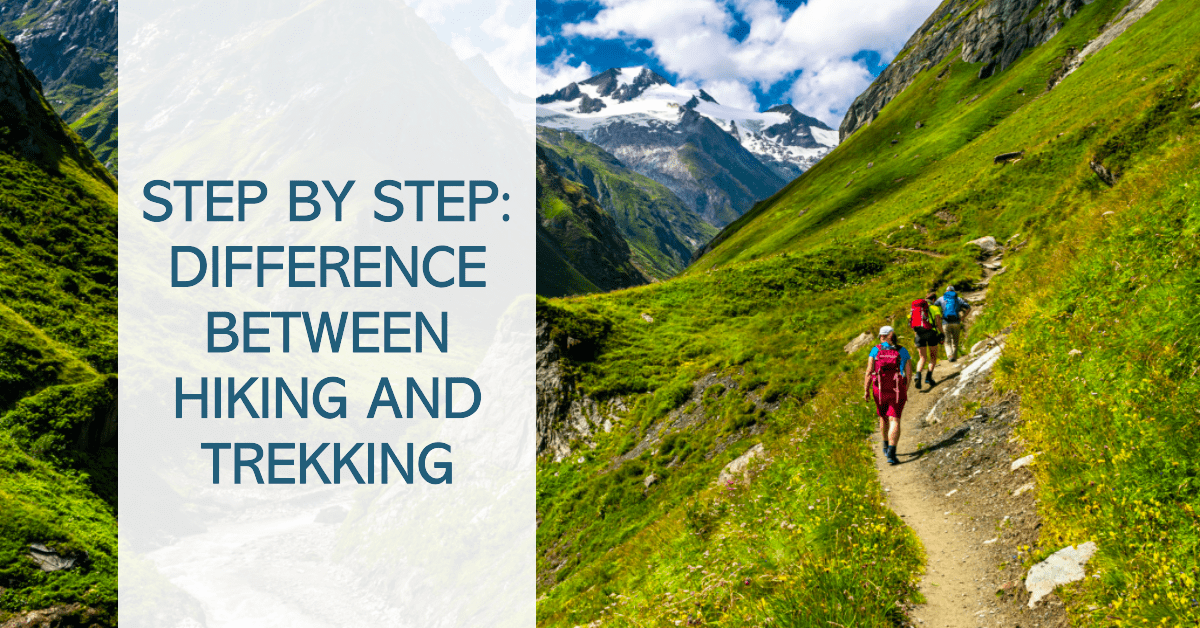Ever found yourself dreaming about the thrill of the outdoors but caught in the middle of the “hiking vs. trekking” debate? If you’ve been grappling with which activity is right for you, or if you’re just curious about the differences, you’re in the right place.
Today, we’re breaking down each activity to help you decide your next outdoor escapade. Ready? Let’s journey together!
Definitions of Hiking vs. Trekking
Before diving into the intricate details, let’s nail down the basics.
- Hiking: Hiking is, at its heart, a leisurely stroll in nature. It’s the perfect pastime for those looking to engage with the outdoors without necessarily pushing their limits. Hikes range from simple paths in local parks to challenging day routes up mountain trails.
- Trekking: Trekking is a more intense commitment. It usually involves multi-day walks in challenging terrains, often remote. While it requires more preparation than hiking, the rewards, both in terms of natural beauty and personal accomplishment, are unparalleled.
Duration and Intensity

The distinction between hiking and trekking goes beyond just the pathways taken. Two central pillars in understanding this distinction are “Time” and “Effort”. Here’s a deep dive to clarify how these aspects differ in each adventure.
Hiking
- Short Duration: One of the hallmarks of hiking is that it is generally shorter in terms of time. Perfect for those who want to be back by sundown, most hikes last from a few hours to the entire day.
- Variable Intensity: Whether you’re a newbie looking for a serene nature walk or an enthusiast chasing the thrill of a challenging uphill battle, hiking caters to all.
- Flat Paths: These are ideal for beginners or those looking for a leisurely experience. Often situated in parks or nature reserves, they offer a smooth and easy walk, allowing you to soak in the beauty without breaking a sweat.
- Uphill Trails: For those wanting to push their limits, there are trails that lead up mountains or through undulating terrains. These require a bit more stamina and give your legs a good workout.
- Your Call: The magic of hiking lies in its adaptability. Whether you wish to challenge yourself or just need a calming stroll, you set the pace and choose the right path.
Trekking
- Extended Adventure: Unlike hiking, trekking is a long-term commitment. It’s an adventure spread across multiple days, sometimes even weeks. With nights spent under the stars or at campsites, it’s as immersive as it gets.
- Demanding Nature: Trekking isn’t for the faint-hearted.
- Unmarked Terrains: Many treks take you to remote locations, where the path isn’t laid out with signs. It’s nature in its purest form, and you’re left to navigate, making the experience both challenging and rewarding.
- Varied Challenges: From crossing turbulent rivers to navigating dense forests or ascending high-altitude zones, treks are packed with a plethora of challenges. Every day on a trek might present a different test of your endurance and willpower.
- Preparation is Key: Given its intense nature, physical fitness plays a significant role in trekking. Regular training, including cardio and strength exercises, can be beneficial, ensuring you’re well-equipped to handle the demands of the journey.
Terrain and Location

Stepping into nature, whether through hiking or trekking, unveils a myriad of terrains and sceneries. However, where you choose to place your footprint heavily influences the kind of experience you’ll glean.
Hiking:
- Local Parks: These are often the first port of call for many hikers. The trails are well-maintained, and they offer a pleasant blend of nature with the occasional park bench to rest. Birds chirping, the rustle of leaves, and maybe even a gentle stream could be your companions.
- Coastal Trails: For those who love the sound of waves crashing and the feel of sand underfoot, coastal trails are a dream. These trails often offer a unique combination of forested paths that open up to breathtaking ocean views.
- Nature Reserves: Reserved for the conservation of wildlife and nature, these spots are typically rich in biodiversity. Here, you might spot a rare bird, a cluster of unique flora, or even a serene pond. Moreover, they’re usually marked with information boards, helping you understand the ecosystem better.
These locations are often accessible, making it easy for a spur-of-the-moment decision to head out and reconnect with nature. Their proximity to urban areas ensures that if the weather turns or if you need a quick exit, you’re never too far from safety.
Trekking:
- Untouched Wilderness: Far from the maddening crowds, trekking often leads you to pristine terrains untouched by modern civilization. These places feel raw, with nature reigning supreme, teaching you humility with every step.
- Deserts: Vast expanses of sand dunes, unique cacti, and the challenge of the relentless sun overhead – desert treks are for those with a heart for the extraordinary.
- Dense Jungles: The dense canopy, the myriad sounds of critters and birds, and the thrill of the unknown make jungle treks an adventure of a lifetime. Every turn might present a new discovery, from a hidden waterfall to a curious animal gaze.
- High Mountain Passes: These treks are a test of endurance. Thin air, challenging climbs, and unpredictable weather are balanced by panoramic views of majestic peaks, deep valleys, and a sense of accomplishment that’s hard to match elsewhere.
The allure of trekking lies in its promise of adventure and the unknown. It might require more planning, but the experience of being in places few have ventured is unparalleled.
Equipment and Preparation

Nature’s embrace feels even better when you’re adequately equipped. The right gear not only ensures a comfortable experience but also ensures safety during your outing. Here’s a detailed look into what you might need based on your adventure of choice.
Hiking:
- Footwear: A hiker’s best friend. Depending on the trail’s roughness, you might opt for trail runners (for well-maintained paths) or hiking boots that offer better ankle support for uneven terrains.
- Light Backpack: This should be spacious enough to carry your essentials but light enough not to weigh you down. Features like multiple compartments and water-resistant materials can be beneficial.
- Hydration: Always carry sufficient water, especially if sources aren’t available along the trail. Hydration bladders, which fit into your backpack, can be a handy alternative to bottles.
- Snacks: Energy bars, nuts, and fruits are excellent for quick energy boosts. Remember, it’s always better to have a bit extra than to run short.
- First-Aid Kit: Accidents can happen. A basic kit with band-aids, antiseptic wipes, painkillers, and any personal medication is a must-have.
- Weather-Appropriate Clothing: Layers are your best bet. This allows you to adjust to changing weather conditions. A lightweight rain jacket might be a lifesaver even if rain isn’t forecasted.
- Insect Repellent: Especially in forested or water-adjacent areas, repellents can keep those pesky bugs at bay, ensuring an itch-free experience.
Going hiking is like going on a day-long nature date. You want to be prepared, but not overly so, making sure you can freely enjoy your surroundings.
Trekking:
- Robust Backpack: Given the longer duration, you need a backpack that can comfortably hold more supplies. Padded straps and support belts can help distribute weight better.
- Footwear: Trekking often involves challenging terrains, making solid, ankle-supporting boots essential. Ensure they’re broken in to prevent blisters.
- Camping Gear: This includes tents, sleeping bags suited for the climate, and possibly a cooking stove if your route doesn’t have food provisions.
- Navigation Tools: In remote areas, signboards are rare. A reliable map, compass, or GPS device becomes invaluable. Familiarise yourself with their usage before setting out.
- Food & Water: Always pack more than you think you’ll need. For water, purification tablets or filters can help you utilise natural water sources.
- Specialised Gear: Depending on where you’re heading, you might need extra equipment. This could range from crampons and ropes for mountainous terrains to hammocks and waterproof bags for jungle treks.
Preparing for a trek is an adventure in itself. It’s a commitment, not just in terms of time but also in ensuring you’re equipped to face the various challenges nature might throw your way.
Safety Note: Remember, preparation is crucial. Always be informed about local conditions, weather forecasts, and necessary safety measures before embarking on any outdoor journey.
Connection with Nature

Nature is the ultimate healer, and both activities provide ample doses.
- Hiking: It’s the perfect weekend therapy. The relatively short duration allows for frequent and varied interactions with nature, perfect for city dwellers seeking a refreshing break.
- Trekking: Consider it a deep dive into the wild. The multi-day nature of treks allows for a profound connection, where the journey becomes just as transformative as the destination.
Conclusion
Deciding between hiking vs trekking boils down to personal preference, physical fitness, and the kind of nature experience you crave. For those keen on a quick, rejuvenating escape, hiking is ideal. But if your heart yearns for a deeper, more challenging communion with nature, trekking is your answer.
Whatever your choice, the world brims with awe-inspiring spots waiting to be explored. So, tie those laces tight, pack that spirit of adventure, and step into the embrace of the great outdoors!







